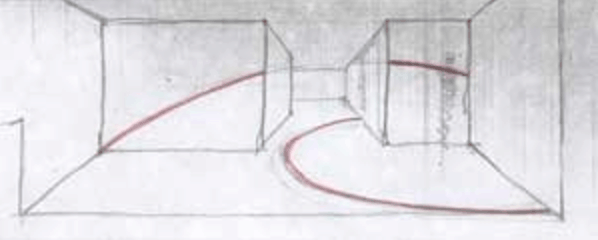Elka Krajewska, Bound: light by Anthony Mccall, sound by Bunita Marcus

In the American experience, scale is all. A big land to conquer. Big dreams to tear out of the world. Big egos, big defeats, big victories. Beyond the American spectrum, scale will more often flitter beyond the spotlight; a thought, an instinct, a budget. Within America, the inclination is to weigh scale—the big novel, the huge public-works installation—as the very soul of the endeavor.
Through this perspective, Americans measure themselves, their arts. We enlarge popular personalities to the scale of the universe: stars. In balance, we harbor our personal insecurities; we fear we are little more than cells, shuffling over a planet, which is itself hardly more than a pixel.
Elka Krajewska’s Bound, a walk through performance at Lehman Maupin Gallery on April 12, led a surging mass of viewers through a meditation on the very big and very small. Krajewska pressed through the hall, toe-tapping button lights on and off, and projecting a bead of light on the walls, ceiling, and crowd. The circle of light—like that produced by a magnifying glass—expanded and jumped with the fits and flurries of a handheld camera. But the beam was also intensely patient, and mesmerized the watchers. In a semi-hypnotic state, viewers followed Krajewska—herself moving trancelike—in a winding and doubling-back exploration of the light sources. Buttons on the walls flickered on and off with the press of Krajewska’s cheek, hip, chin.
A score by Bunita Marcus ommed quietly in the recesses. The music, created by striking and stroking chords inside a grand piano, gave the impression of the sounds inside one’s body—or in a hushed engine room, generating, working, but in a zen-like mum.
The ongoing nature of Bound accentuates this sense of perpetual engine and perpetual movement. The moment of the light snapping on, or off, is bound to an instant, but that instant of consciousness is no more than a single point. Krajewska—now working on a diagrammatic set of drawings elaborating on the performance, as well as a video—has no intention of giving us a proper beginning or ending. The collaborative side of the project—with Marcus’s composition and a “light score” by Anthony McCall—sets Krajewska as a cell in another body, with its own lifecycle.
The origins of Bound are equally evolutionary; the piece previewed at the Orchard Gallery in 2007, and in turn was a response to a fragment of a 1989 film by Karin Schneider and Nicolas Guagnini, which in turn incorporated a recorded demonstration of Hand Dialog, an interactive work by Clark and Hélio Oiticica from 1966. Hand Dialog, an elastic Möbius strip, endlessly joins by the wrist two moving hands. In keeping with the solitary/solidary juxtaposition in Bound, the sited demonstration of Hand Dialog employs only one user, while the assumption (“dialog” not “monologue”) would be that Hand Dialog was originally intended to join two different people.
Krajewska’s hands, crossed and bound in video equipment throughout the performance, bring this contemporary trope to the forefront. We are more solitary than ever—alone at our computer screens. But we are also, increasingly, part of an entirety: everyone is tracked and on the grid, and we interact, through email/web/social sites, with anyone we want, whenever.
There, perhaps, is the great horror and promise of our moment. We are becoming something larger. And we are posed with the question: shall we also become larger in spirit.
Originally Published March 22, 2012
